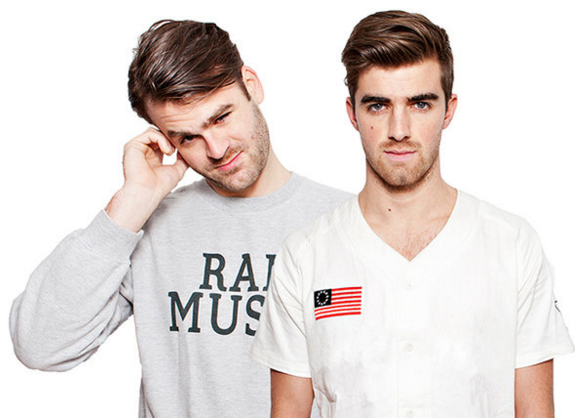Shout-out to Justin Bieber.
If you’re anything like me, you may have heard “Roses” by the Chainsmokers some time in the past couple of months and wondered how on earth the duo that brought us the self-aware “#Selfie” and reverential “Kanye” could muster a song this eclectic, adventurous and immediately captivating. The sleeper hit rocketed up the Billboard Hot 100 chart this week to number 6, surpassing “Selfie” as The Chainsmokers’ highest charting number and the duo performed the song live alongside singer Rozes last night on The Tonight Show with Jimmy Fallon. However, the song itself doesn’t adhere to what we might expect from typical pop music, featuring colorful instrumental layers and vocal texturing. “Roses” is a daring synthesis of recent popular sounds that we would never expect to jive outside of an experimental record—and even less so on contemporary hit radio, where “Roses” has comfortably seeded itself.
So what’s the deal with the commercial success of “Roses?” Your ears aren’t lying to you, “Roses” is definitely a unique earworm of a song, but “Roses” also owes its popularity to three major music influences over the past four years. “Roses” would not be charting right now if it were not for the likes of artists like Lorde, Of Mice and Men and even Justin Bieber, who undoubtedly paved the way for The Chainsmokers’ newest spark of a song to electrify 2016.
Reason #1: The Introduction – The breathy indie-pop female musing over a sparse beat.
Influence: Lorde, “Royals”
Around the 11 second mark of Roses, we’re treated to the sultry, R&B tinged vocals of the lead singer (Rozes) over a deep kick drum and snap:
We love this sound because we have been hearing it everywhere since 2013. When Rozes croons “Take it slow, but it’s not typical” it’s hard not to think back to a time when this slow beat form wasn’t typical, like maybe before this song debuted back in 2013:
This sound in “Roses” was defined back in 2013 with Lorde’s kick drum and clap driven “Royals,” and America (and the world) loved it. The song topped the Billboard Hot 100 chart in the US for nine straight weeks. In both “Royals” and “Roses,” the minimal beat serves as an unassuming background, allowing the main vocalist’s voice to capture our attention. Artists like Selena Gomez and Banks have also evoked this style of sultry crooning over the past few years, releasing music that highlights the breathy and colorful tonal qualities of their vocals over a barely-there beat. Today this type of vocal and beat is totally typical, but it’s a sound that we can’t get enough of.
Reason #2: The Verse – Icelandic folk pop beside a campfire.
Influence: Of Monsters and Men, “Little Talks”
This one is a bit more out there. Remember in 2012 when Of Monsters and Men’s quirky “Little Talks” graced the radio? The duet featuring Icelandic singers Nanna Bryndís Hilmarsdóttir and Ragnar Þórhallsson brought the intimate warmth of a couple singing before a crackling campfire to the pop music world. Let’s look at this part in particular which comes in at the bridge in “Little Talks” at 2 minutes, 36 seconds:
Nanna and Ragnar are singing the bridge of the song together in unison (in their own respective octaves) after the accompaniment drops out. The lyrics here are the saddest, ending with “Just let me go / We’ll meet again soon” which feels like a statement that is deeply personal to the speakers. Now listen to this part of “Roses” at 50 seconds in:
Rozes and Andrew Taggart sing in unison at the octave as an acoustic(!) guitar strums in the background. Taggart’s voice adds a depth to Rozes’ and wonderfully complements the inherently smoky qualities of her voice. As Rozes and Taggart sing “Deep in my bones I can feel you” we are swept to a lit campfire back in 2012 where we are treated to an acoustic performance at sunrise; long-gone are the icy, minimalist beats of the opening of the song. Like “Little Talks,” “Rozes” grabs us and pulls us in immediately as Rozes and Taggart whisper into our ears.
Reason #3 : That chill drop.
Influence: Justin Bieber, “Sorry”
Justin Bieber is probably the single biggest reason why “Roses” is finally hitting the airwaves hard after being released way back in June 2015. Check out this beat drop in Bieber’s “Sorry”:
This drop is subdued and totally different from the sledgehammer beat drops we might associate with the songs we’ve heard from the song’s producer, EDM master Skrillex. Bieber chants “Sorry” over the beat drop and the production of the song becomes its focus for the next 22 seconds as Bieber sings “Sorry” over the bouncy beat. “Roses” does something similar:
Rozes pleads “say you’ll never let me go” over a warm, tropical dubstep that is closer to Bieber’s “Sorry” than say, Skrillex’s “Bangarang.” Rozes interjects with “uh”s and a few words for a whole 58 seconds over the groove before the next verse comes in. This 58 second drop is over double the length of the drop in “Sorry” and undoubtedly able to hold our attention thanks to Bieber’s previous use of the beat drop as centerpiece and his prominence on pop radio since last summer (as of this week’s chart, Bieber’s “Sorry” has been in the top 2 of the Billboard Hot 100 for 14 weeks straight).
Without Bieber, we probably weren’t ready for the sonic delight that is the Chainsmokers’ “Roses.” The song builds off of both Lorde’s and Of Monsters and Men’s top 40 offerings of the past few years and incorporates the structures we’ve come to expect since Bieber’s music took a bold turn in 2015. But “Roses” does an amazing job of taking us to these lush and highly different soundscapes in a way that only The Chainsmokers have managed in recent memory.
-Shane


Incredible analysis Shane! Looking at my Spotify I actually have Sorry followed by Roses in a playlist I made awhile back. Would love to see more of these.
Awesome! I noted the vi IV I I progression in Roses is similar to Tay-Tay’s Shake It Off with ii IV I I, the way it settles in the tonic in the latter half of every phrase. It’s the same progression as Katy Perry’s “Unconditionally”, actually. Also “sultry crooning” is the best description of Selena that I’ve ever read. Can’t wait to read more!
Thanks, neighbor. Haha, that’s an awesome coincidence; you must have heard the similarities between the two maybe without even knowing it. I will definitely be posting more, thanks for checking this out!
Thanks, Craig. I had no idea about the similarities between “Roses,” “Shake It Off,” and “Unconditionally.” I’m still getting used to listening to chord changes and such at a deeper level, but maybe there’s a different feel between the vi IV versus the ii IV that sets “Shake It Off” apart?
I tend to see the vi IV I I and ii IV I I as spin-offs of the “sensitive female” chord progression made famous by Joan Osbourne’s “What if God Was One of Us?” That chord progression (still used today) was generally written out as vi IV I V. The “Roses” progression doesn’t quite get to the V, as you mention, so we get that colorful plagal cadence that settles on the tonic for a bit longer than we’re used to. Maybe it’s a bit more calming since we never get the dramatic V-I gesture that we hear everywhere in music? I’d be curious to hear what you think. Also lol so sultry~* Thanks for your comment!
Awesome Ananlysis Dude… That royal part, same thing was on my mind.. U Did a great job.. I lyk ur review buddy…